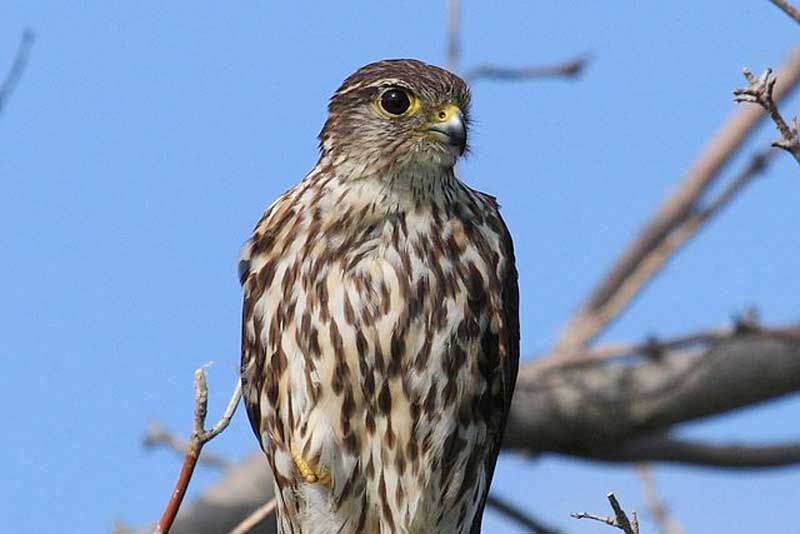Jan 14, 2015
by Lorraine Julien
This fall I purchased a very effective bird feeder pole with a squirrel baffle guaranteed to keep raccoons and squirrels from raiding the bird feeders. It has been very effective – the baffle works so well that after one look, the squirrels do not even try to scale the pole. The squirrels do not go hungry as there is usually lots of seed droppings scattered about by my feathered friends.
Now that I had foiled attempts by predators from beneath the feeders, I had completely overlooked dangers from the sky. One or two hawks had been seen flying around in the general area but we didn’t give it much thought until my husband and I were out for a walk late one afternoon just after Christmas. We were strolling along when all at once I noticed some light bits of grey floating to the ground. I thought at first that someone had lit a fireplace or stove in the area but we looked closer and saw that the bits of grey were fluffy little feathers. We looked up as there happened to be a lamp post directly above our heads. In the dim light of late afternoon, we thought the bird was a small hawk – our vision was further obscured by the large lamp. Its meal was almost finished – perhaps a little sparrow or junco. A few minutes later, the predator flew away with a series of strong wing beats but, in the dimming light, all we could see was its silhouette. Unfortunately I didn’t have my camera so couldn’t get a photo.
After some research and advice from a local birder, I discovered that the little hawk was probably a member of the Falcon family. This particular falcon is called a Merlin - one of the speediest and most powerful of the falcons able to overtake and capture a wide variety of prey. These birds can turn on a dime and use their long, thin toes, typical of falcons, to pluck birds from the air after launching a direct attack.
There are a number of big spruce trees near my feeders which provide shelter for the little birds. Unfortunately, the trees also provide cover for birds of prey. Ounce for ounce, few birds can rival the spunky little Merlin, so swift and agile that it can outmaneuver even such masters of flight as dragonflies and tree swallows! Dragonflies are a handy little snack during the summer months in between meals of songbirds.
Merlins are real “creatures of opportunity” and will readily take prey that is flushed by something else. They’ve been seen tagging along after sharp-shinned hawks to catch birds that escape into the open air. It seems they are not afraid of anything and will readily attack anything that moves.
During the nesting season, the male Merlin will streak across a clearing with a freshly killed bird in his claws. The female will spring from her nest and fly out to meet him. His claws open and the prize plummets downward toward the female some 50 feet below. Darting under it, she rolls onto her back, reaches up, and skillfully latches onto her meal.
Merlins are only about 10-14 inches long, with a wingspan of perhaps 24 inches. The Merlin’s wings – long and sharply tapered like those of jet fighters – beat with rapid downward flicking power strokes (a similar posture and flight style to that of pigeons, hence the former name for this bird – Pigeon Hawk). You can tell Merlins from other falcons because of these rapid wingbeats and the fact they rarely glide. They are generally dark and streaky, though their coloration varies. The dark tail has narrow white bands, the chest is heavily streaked and the under wings are dark.
Corvids (crows) are the primary threat to eggs and nestlings. There is not very much protection as the Merlin is a bit lazy when it comes to building nests. Most will use abandoned crow or hawk nests that are in conifer or mixed tree stands. In open areas, where there are few trees, the female may use a shallow scrape on the ground or nest in rock crevices. They’ve even been known to nest in buildings (abandoned buildings, old barns, etc).
In medieval times, Merlins were popular in falconry. Today they are still occasionally trained by falconers for hunting smaller birds such as sparrows and starlings but this is not as common as in the past. The Merlin is only slightly larger than the American Kestrel in dimensions, but it averages about one third larger by weight. The extra weight is mostly muscle, which gives it greater speed and endurance than the Kestrel.
Merlins seem to be moving northward, especially into urban areas. Populations have largely recovered from 20th century declines, thanks to a ban on the pesticide DDT and their ability to adapt to life around towns and cities. An added bonus is the large number of urban bird feeders, providing a never-ending supply of little birds. Small mammals, especially bats and voles, and reptiles also complement the diet.
As much as our resident Merlin is an interesting character, I wish it would fly south for a while so that we can enjoy our feeder birds. Since the Merlin arrived, I hardly ever see the regular birds, with the exception of mourning doves which, because of their size, may be a bit more difficult to catch.
More Stories
- Harrowsmith Public School and the Magic of Theatre
- You’re a Good Man Charlie Brown – a school wide effort at SHS
- Leadership From Within
- New Bulk Water Station in Sydenham
- Frontenac County Council looks at Healthcare Recruitment
- Good Turn Out Maple Fest Despite Rain
- Future looking brighter for Denbigh Fire Department says Chief
- Local Favourites featured at 2nd Annual SF Music Festival
- Perth Festival of the Maples, Saturday, April 27
- South Frontenac Council

